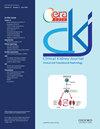用于预测急性胰腺炎相关急性肾损伤重症患者死亡率的机器学习模型
IF 3.9
2区 医学
Q1 UROLOGY & NEPHROLOGY
引用次数: 0
摘要
背景 急性肾损伤(AKI)的发生与急性胰腺炎(AP)患者死亡率的增加有关,这表明早期准确预测急性胰腺炎相关急性肾损伤(AP-AKI)重症患者死亡率的重要性。本研究旨在开发和验证基于机器学习的急性胰腺炎相关急性肾损伤重症患者院内死亡率预测模型,并将其与传统的逻辑回归(LR)模型进行比较。方法 本研究使用了三个临床数据库的数据。预测因子通过递归特征消除算法确定。使用十倍交叉验证法开发了 LR 模型和两种机器学习模型,包括随机森林(RF)和极端梯度提升(XGBoost),用于预测 AP-AKI 患者的院内死亡率。结果 共有 1,089 名来自重症监护医学信息中心-IV(MIMIC-IV)和 eICU 合作研究数据库(eICU-CRD)的患者被纳入训练集,176 名来自湘雅医院的患者被纳入外部验证集。训练集和外部验证集的院内死亡率分别为13.77%和54.55%。与LR模型和RF模型的AUC值相比,XGBoost模型的AUC值[0.941,95%置信区间(CI):0.931-0.952]明显更高(均为P<0.001),且XGBoost模型在训练集中的Brier得分最小,为0.039。在外部验证集中,XGBoost 模型的 AUC 值为 0.724(95% CI:0.648-0.800),表现尚可。但是,它与 LR 模型和 RF 模型的差异不大。结论 XGBoost 模型在训练集的区分度和校准方面均优于 LR 和 RF 模型,但这一结论能否推广还需要进一步验证。本文章由计算机程序翻译,如有差异,请以英文原文为准。
Machine learning models for mortality prediction in critically ill patients with acute pancreatitis-associated acute kidney injury
Background The occurrence of acute kidney injury (AKI) was associated with an increased mortality rate among acute pancreatitis (AP) patients, indicating the importance of accurately predicting the mortality rate of critically ill patients with acute pancreatitis-associated acute kidney injury (AP-AKI) at an early stage. This study aimed to develop and validate machine learning-based predictive models for in-hospital mortality rate in critically ill patients with AP-AKI by comparing their performance with the traditional logistic regression (LR) model. Methods This study used the data from three clinical databases. The predictors were identified by the Recursive Feature Elimination algorithm. The LR and two machine learning models including random forest (RF) and extreme gradient boosting (XGBoost) were developed using the ten-fold cross-validation to predict in-hospital mortality rate in AP-AKI patients. Results A total of 1,089 patients from Medical Information Mart for Intensive Care-IV (MIMIC-IV) and eICU Collaborative Research Database (eICU-CRD) were included in the training set, and 176 patients from Xiangya Hospital were included in the external validation set. The in-hospital mortality rate of the training and external validation sets was 13.77% and 54.55%, respectively. Compared to the AUC values of the LR model and the RF model, the AUC value of the XGBoost model [0.941, 95% confidence interval (CI): 0.931-0.952] was significantly higher (both P < 0.001), and the XGBoost model had the smallest Brier score of 0.039 in the training set. In the external validation set, the performance of the XGBoost model was acceptable with an AUC value of 0.724 (95% CI: 0.648-0.800). However, it did not differ significantly from the LR and RF model models. Conclusions The XGBoost model was superior to the LR and RF models in terms of both the discrimination and calibration in the training set, while whether the findings can be generalized needs to be further validated.
求助全文
通过发布文献求助,成功后即可免费获取论文全文。
去求助
来源期刊

Clinical Kidney Journal
Medicine-Transplantation
CiteScore
6.70
自引率
10.90%
发文量
242
审稿时长
8 weeks
期刊介绍:
About the Journal
Clinical Kidney Journal: Clinical and Translational Nephrology (ckj), an official journal of the ERA-EDTA (European Renal Association-European Dialysis and Transplant Association), is a fully open access, online only journal publishing bimonthly. The journal is an essential educational and training resource integrating clinical, translational and educational research into clinical practice. ckj aims to contribute to a translational research culture among nephrologists and kidney pathologists that helps close the gap between basic researchers and practicing clinicians and promote sorely needed innovation in the Nephrology field. All research articles in this journal have undergone peer review.
 求助内容:
求助内容: 应助结果提醒方式:
应助结果提醒方式:


